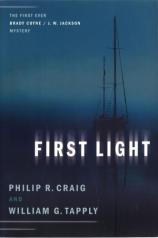First Light
Review
First Light
FIRST LIGHT is an interesting collaboration, to say the least. Philip R. Craig is known for his mystery novels featuring J. W. Jackson, a retired cop living on Martha's Vineyard, who grudgingly dabbles in occasional private investigation. William Tapply is best known to mystery novel aficionados as the creator of Brady Coyne, a Boston attorney whose cases involve equal application of legal knowledge and detective skills. Craig and Tapply, who are friends in this world, bring their creations together in a literary one, and the result is certainly worth a look.
Craig and Tapply do not attempt a seamless melding of their literary styles in FIRST LIGHT. The authors alternate chapters, with each of them featuring their creation's point of view, but interacting with the other. The setup for FIRST LIGHT is that Jackson and Coyne, despite their disparate backgrounds, have been friends for some time. As FIRST LIGHT opens, Jackson has been retained by James Bannerman, whose wife Katherine has left him and was last seen around Martha's Vineyard. Coyne, on the other hand, has come to Martha's Vineyard for a combination of business and pleasure. He has been retained by one of his oldest clients, Sarah Fairchild, to assist her in the sale of her Vineyard property, which is highly coveted by a country club concern and an environmentalist group. Nate and Eliza, Sarah's ne'er-do-well adult children, and Eliza's son Patrick are also interested in the sale for reasons of their own. The pleasure part of his trip involves partaking in an annual fishing competition with his friend Jackson. Their business concerns begin to dovetail, however, when Coyne meets Molly Wood. Wood, who is a friend of Jackson and his wife, and is also Sarah Fairchild's nurse, meets Coyne and agrees to a date --- then disappears. Coyne and Jackson find themselves looking for two different women whose disappearances seem increasingly similar.
What is interesting here is that Craig and Tapply seem stylistically matched for collaborations. Their alternating of chapters is not jarring in the least; the story flows along smoothly enough and is nicely paced to its conclusion. Perhaps the success of this volume will prompt more joint works between Craig and Tapply and future meetings between Coyne and Jackson. They will be welcome.
Reviewed by Joe Hartlaub on December 18, 2001




